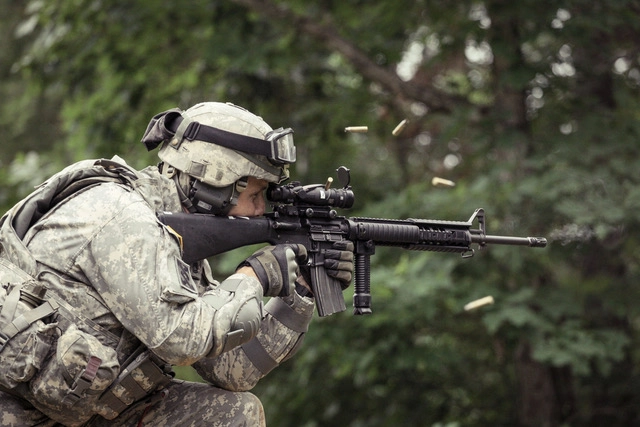
The United States (US) military operates on a global scale, with a vast network of bases and installations spread across various continents. Among these, the largest and most influential are the many sprawling military bases within its own borders. One such base stands out for its sheer magnitude and significance - an emblem of American military power and strategy.
Large military bases function like compact urban centers, even having their unique zip codes. It’s even possible to reside and coexist within the base premises, enjoying the convenience of on-base shopping, recreational options, and social gatherings.
Moreover, military bases commonly host not only service members but their families too as well as a substantial number of civilian staff. This collaborative effort ensures the smooth functioning and continuous operation of the military facilities.
Therefore, in this article, I want to delve into an exploration of the largest US military bases, uncovering their size, operations, and roles in shaping the nation’s defense landscape.
Introduction to Military Bases
Military bases are integral components of a nation’s defense infrastructure, serving as hubs for training, deployment, logistics, and strategic planning. The US maintains a vast array of military bases both at home and abroad, each designed to fulfill specific roles within the broader national security strategy. This time, we will exclusively focus on the military bases located in the US.
1. Fort Liberty (formerly Fort Bragg) - the largest US military base
Fort Bragg, located in North Carolina near the city of Fayetteville, takes the spotlight as the largest US military base in terms of physical size and operational capacity. It has a population of over 260,000 people. Covering an astonishing 251 square miles, Fort Bragg stands as a testament to the scale at which the US military operates.
Named for Confederate General Braxton Bragg, the base was established in 1918, initially operating as an artillery training center. With expansion happening at a steady pace, by the summer of 1940, it housed a total of 5,400 soldiers. It has since evolved into a dynamic and multifaceted installation with a rich history.
Training excellence
Fort Bragg is renowned for its exceptional training facilities, catering to the various branches of the US military. It serves as the headquarters for the XVIII Airborne Corps and the 82nd Airborne Division, both of which are known for their rapid deployment capabilities. The base’s vast training grounds facilitate realistic scenarios, from urban combat to airborne operations, allowing soldiers to hone their skills in diverse environments.
Special operations
Fort Bragg plays a pivotal role in the US Special Operations Forces (SOF). It is home to the United States Army Special Operations Command (USASOC), overseeing elite units such as the Green Berets, Rangers, and Special Forces. These units are at the forefront of unconventional warfare, counterterrorism, and special reconnaissance.
Global reach
The strategic location of Fort Bragg along the Pacific Coast allows easy access to both domestic and international deployment routes. This positioning enables rapid response to crises, humanitarian missions, and overseas operations.
2. Fort Cavazos (formerly Fort Hood)
Situated in Killeen, Texas, Fort Hood covers about 340 square miles. The military base’s population is over 227,000. It is known as the ‘Great Place’ due to the high standard of living it provides.
Fort Hood first came into existence when General Marshall brought the Tank Destroyer Force into action on November 21, 1941. Their primary objective was to locate, engage, and eliminate enemy tanks, with an avowed mission of seeking, striking, and destroying such armored threats.
Today, Fort Hood specializes in the training of armored and mechanized units, with a focus on maintaining combat readiness. Some of its most important divisions and brigades include the 1st Cavalry Division, 3rd Cavalry Regiment, 13th Sustainment Command (Expeditionary), 89th Military Police Brigade, and 504th Military Intelligence Brigade.
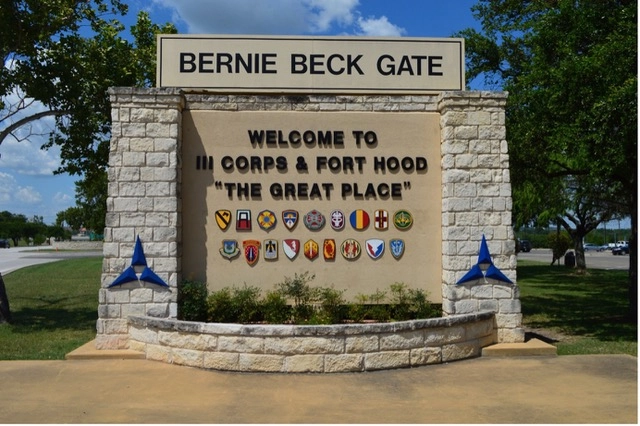
3. Fort Moore (formerly Fort Benning)
Located near the city of Columbus, Georgia, Fort Benning covers around 284 square miles. It goes beyond the boundary confines of Georgia, extending slightly into the neighboring state of Alabama.
The base supports a population exceeding 120,000, including active-duty military personnel, their family members, reserve soldiers, retirees, and other employees.
It was established in 1918, and tasked with delivering fundamental training to units in World War I, along with a brief involvement in training tank units. During World War II, it emerged as a principal hub for infantry and airborne training, in addition to serving as an officer candidate school.
Today, Fort Benning provides the headquarters for several units, including the United States Army Maneuver Center of Excellence, the 198th Infantry Brigade, the 194th Armored Brigade, the 316th Cavalry Brigade, and the 1st Security Force Assistance Brigade, among others.
As the ‘Home of the Infantry’, Fort Benning continues to be a crucial training center for infantry, armor, and airborne forces. The base’s Maneuver Center of Excellence focuses on developing modern warfighting tactics and techniques.
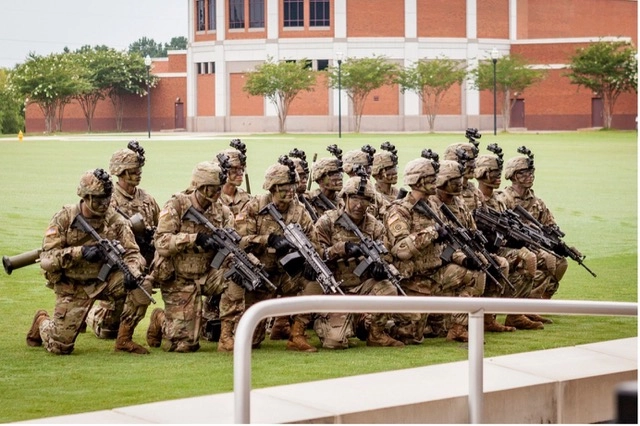
4. Joint Base Lewis-McChord
Joint Base Lewis-McChord (JBLM) is an amalgamation of the Fort Lewis and McChord Air Force Bases, which were combined back in 2010). It spans around 647 square miles in Washington state. This encompasses 142 square miles for its main base in western Washington and an expansive 505 square miles for the Yakima Training Center. Around 110,000 individuals make up the population of the joint base.
JBLM is a hugely significant military installation on the West Coast, serving as a hub for both Army and U.S. Air Force operations. Some of the units based there include the 7th Infantry Division, the 2nd Infantry Division Stryker Brigade Combat Team, and the 62nd Airlift Wing.
With its diverse array of units and resources, JBLM contributes to the readiness and capabilities of the U.S. military on a regional and global scale, facilitating rapid deployment, training, logistics, and joint operations. The base’s strategic location also supports rapid deployment and readiness within the Pacific region.
5. Marine Corps Base Camp Pendleton
Located in Southern California, Camp Pendleton is the primary West Coast training facility for the United States Marine Corps. It’s estimated that the base supports a population of around 100,000 people, including active-duty Marines, their families, civilian employees, and other personnel.
During the early 1940s, both the Army and Marine Corps sought a suitable expanse for a sizeable training facility. Therefore, in 1942 the vast 191 square miles of Rancho Santa Margarita y Las Flores was transformed into the nation’s largest Marine Corps base.
Now covering more than 195 square miles, the base boasts extensive amphibious assault training areas and serves as a hub for Marine Expeditionary Force training. It comprises various divisions, regiments, and supporting units.
The notable units and commands stationed at Camp Pendleton include the 1st Marine Division. Known as the ‘Blue Diamond’, this is the oldest, largest, and most decorated division in the Marine Corps.
The 1st Marine Logistics Group is also responsible for providing logistics support to the I Marine Expeditionary Force and its subordinate units. It ensures that the necessary resources, supplies, and equipment are available for operational readiness.
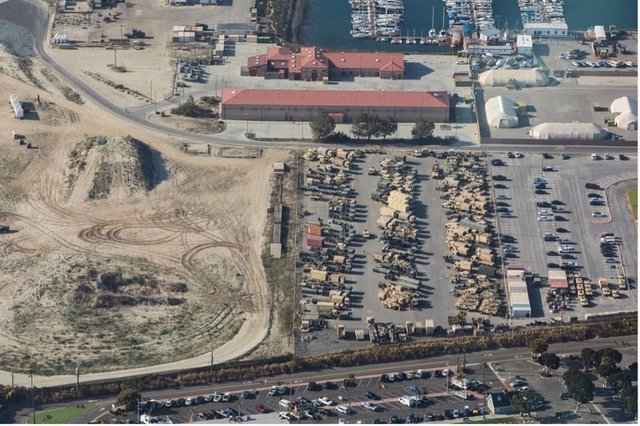
6. Fort Campbell
Standing at the Kentucky-Tennessee border, Fort Campbell spans around 164 square miles. Based on the most recent Army forecasts, Fort Campbell is expected to maintain its role of accommodating a substantial military community (consisting of approximately 30,029 active component soldiers) for the foreseeable future. Currently, Fort Campbell supports a population of over 250,000 individuals.
Home to the 101st Airborne Division (Air Assault) and the 160th Special Operations Aviation Regiment, the base is known for its rapid response capabilities and Special Operations readiness.
The 101st Airborne Division, famously referred to as the ‘Screaming Eagles’, has a long history that dates back to World War II. Renowned for its distinctive air assault capabilities, the division can rapidly deploy and engage in combat or humanitarian operations from helicopters.
The 160th Special Operations Aviation Regiment is a premier aviation unit specializing in providing air support to Special Operations forces. Operating under the cover of night and adverse conditions, this regiment is known as the ‘Night Stalkers’. Precision and expertise enable them to carry out complex missions such as air assaults, reconnaissance, and direct-action operations, often in the most challenging environments.
7. Marine Corps Base Camp Lejeune
Located near Jacksonville, North Carolina, Camp Lejeune covers 246 square miles. Its population of around 137,000 people encompasses Marines, sailors, retirees, families, and civilian employees.
The base supports expeditionary warfare training and serves as the home of the II Marine Expeditionary Force (II MEF). Amongst the notable units stationed at Camp Lejeune is the 2nd Marine Division. Known as the ‘Warlords’, they specialize in amphibious assaults and mechanized infantry operations.
The 2nd Marine Logistics Group is also responsible for providing logistics and combat service support to II MEF, ensuring that troops are well-equipped and supplied for various missions.
8. Eglin Air Force Base
Located near Valparaiso, Florida, Eglin Air Force Base covers over 723 square miles and houses more than 71,500 personnel.
It is the largest Air Force base of all in terms of land area and it plays a critical role in testing and developing new weapons systems, including aerospace technologies.
It also boasts a diverse array of units and divisions that contribute to its vital role in the U.S. Air Force. Among its notable components are the 96th Test Wing and the 33rd Fighter Wing. The 96th Test Wing specializes in evaluating and testing the effectiveness of various weapons and equipment to enhance the Air Force’s combat capabilities. Meanwhile, the 33rd Fighter Wing focuses on training F-35 Lightning II pilots, ensuring that they are prepared to operate this advanced fifth-generation fighter aircraft.
Additionally, Eglin’s auxiliary fields contribute significantly to its operations. These include Duke Field, which supports Air Force Special Operations Command, and Hurlburt Field, which is a hub for Special Operations forces.
9. Naval Station Norfolk
Situated in Norfolk, Virginia, Naval Station Norfolk is the world’s largest naval station, featuring a fleet of 75 ships aligned along 14 piers, along with 134 aircraft and 11 aircraft hangars at the closely managed Chambers Field. It encompasses an area exceeding six square miles of land.
With a population of over 233,000 individuals, the area accommodates a substantial and diverse community that includes active-duty personnel, retirees, family members, and more.
It is a key operational hub for the U.S. Navy, supporting a wide range of naval vessels and serving as a strategic base for the Atlantic Fleet. It serves as the home port for four carrier strike groups, along with their designated vessels.
Naval Station Norfolk not only serves as a hub for surface vessels, but also boasts a dynamic presence of squadrons, submarines, and various naval assets.
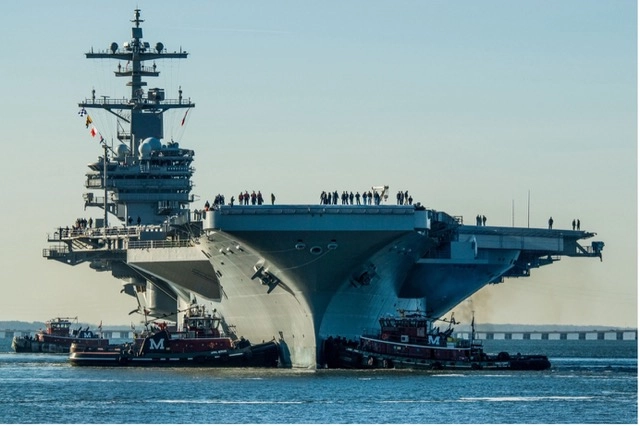
10. Fort Bliss
Situated in El Paso, Texas, Fort Bliss covers approximately 1,700 square miles and spans both Texas and New Mexico. It employs a combined population of around 167,000 people.
A historic U.S. Army base, it was established on January 8, 1849, as a cavalry post to provide protection for settlers and travelers along the El Paso del Norte (now Ciudad Juárez) and San Antonio wagon route. The base is now known for its artillery and missile defense training, making it a key asset in the nation’s defense against missile threats.
Fort Bliss hosts various testing and training exercises, ensuring soldiers are prepared for a range of scenarios. Its notable units include the 1st Armored Division, which holds the distinction of being the oldest armored division within the United States Army, the 11th ADA ‘IMPERIAL’ Brigade, and the 32nd Army Air, and Missile Defense Command.
Also, based at Fort Bliss is the Mobilization Brigade. They are responsible for overseeing and facilitating the mobilization, training, and deployment of Reserve and National Guard units.
Summary of the Largest US Military Bases
| US Military Base | Size (in square miles) | Population |
|---|---|---|
| 1. Fort Liberty | 251 | 260,000 |
| 2. Fort Cavazos | 340 | 227,000 |
| 3. Fort Moore | 284 | 120,000 |
| 4. Joint Base Lewis-McChord | 647 | 110,000 |
| 5. Marine Corps Base Camp Lejeune | 246 | 137,000 |
| 6. Fort Campbell | 164 | 250,000 |
| 7. Marine Corps Base Camp Pendleton | 195 | 100,000 |
| 8. Eglin Air Force Base | 723 | 71,500 |
| 9. Naval Station Norfolk | 6 | 233,000 |
| 10. Fort Bliss | 1,7 | 167,000 |